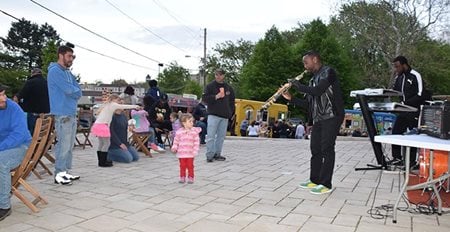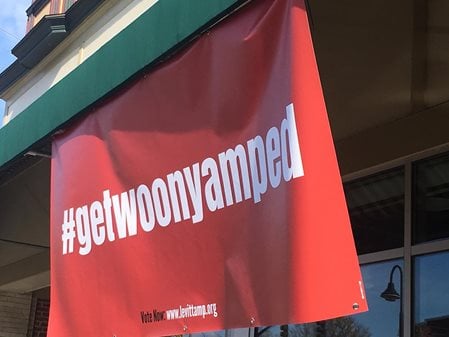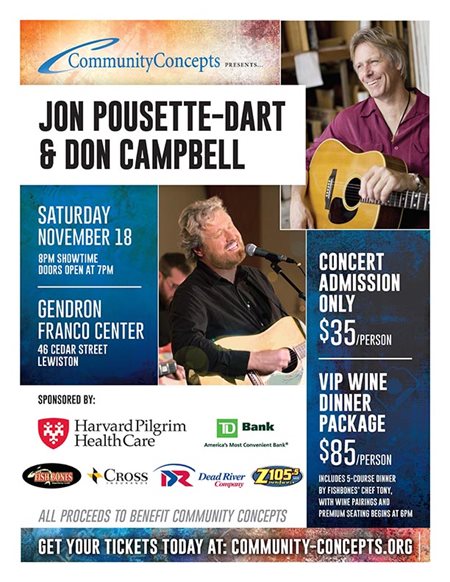“Music is a moral law. It gives soul to the universe, wings to the mind and flight to the imagination.” These are the words of Plato, and centuries later, music continues to be a building block of community-building and engagement.
Two members of the NeighborWorks network offer good examples of how the universal attraction of music can be harnessed to bring people together.
NeighborWorks Blackstone River Valley: Community-building
NeighborWorks Blackstone River Valley (NWBRV) has worked since 2015 to redevelop the Woonsocket, Rhode Island, historic district, located at the gateway to the local downtown. The project is designed to transform a collection of industrial-aged mill buildings into a center of art, culture and technology (hence the name “ArTech Hub”), thus spurring economic development. Funds from the Local Initiative Support Corp. (LISC) helped kick off the creative placemaking project, allowing NWBRV to make grant funds available for activities involving art, food and/or music. Food trucks offered tastes of local food (now discontinued due to fears of competition among area restaurants), a book fair featured local authors, youth performed spoken-word poetry and immigrant communities offered dance lessons and American Indians put on a drum circle allowing public participation.
Funds from the Local Initiative Support Corp. (LISC) helped kick off the creative placemaking project, allowing NWBRV to make grant funds available for activities involving art, food and/or music. Food trucks offered tastes of local food (now discontinued due to fears of competition among area restaurants), a book fair featured local authors, youth performed spoken-word poetry and immigrant communities offered dance lessons and American Indians put on a drum circle allowing public participation.“Music wasn’t a specific focus, but we learned that when there is music, people stay. They don’t just come for the food and leave; they stay for a couple of hours,” says Meghan Rego, director of resource development and communications. “We heard stories of people meeting each other for the first time, even though they came from the same block!”
NWBRV wanted to put more of a focus on music, but LISC funding had wound down. Then Rego learned about another grant opportunity through a United Way listserv--the Levitt AMP [Your City] Grant Awards. (That illustrates a point Rego makes: It’s easy to fall behind in reading these types of emails, but consider what you could miss!) The matching-grant program is sponsored by the Mortimer & Mimi Levitt Foundation, a national creative placemaking funder dedicated to strengthening the social fabric of America through the power of free, live music in small to mid-sized towns. Each grantee receives $25,000 in matching funds to organize at least 10 free, outdoor concerts over 10 to 12 consecutive weeks. Up to half of the matching requirement may be in-kind donations, such as sound equipment or marketing services.
In addition to its specific focus, what makes this grant program a bit unique are the heavy emphasis on partnerships and the public, online voting process used to select the 25 finalists. (The ultimate 15 winners for 2018, announced Jan. 2, were selected by the foundation board.)
“We had to have10 partners signed on and to prove we had lot of sponsors as well, since we needed to match the foundation’s grant,” says Rego, adding that NWBRV was one of two Rhode Island nonprofits to enter. “And then there was the online contest. It was a lot of work to ‘get out the vote’ during the 20-day polling period, but it turned out to be so helpful in mobilizing the community and engaging residents in our work.”
 NWBRV formed a committee to work on the campaign, which adopted the hashtag #getwoonyamped. The hashtag was promoted on social media, on street banners and signs in local business windows, and even over the loudspeaker at the local high school—where students were allowed to take out their smartphones in class and vote. Even pastors preached the message from the pulpit.
NWBRV formed a committee to work on the campaign, which adopted the hashtag #getwoonyamped. The hashtag was promoted on social media, on street banners and signs in local business windows, and even over the loudspeaker at the local high school—where students were allowed to take out their smartphones in class and vote. Even pastors preached the message from the pulpit.“People in town were really into the music scene at the time, because one of our own, Woonsocket’s Emily Luther, was competing on the NBC show ‘The Voice,’” says Rego. (She just missed becoming one of the final 12 contestants.) “Even the mayor got into it, filming a video for Facebook saying, ‘I just voted and I want everyone else to get wooney amped too.’”
When the news came that NWBRV not only was one of the vote winners but had been selected to receive a grant, the word swept the town. Now, the nonprofit is continuing the community-engagement momentum by seeking nominations for the musicians to be featured in the summer series (Friday nights, June 29-Aug. 31) and recruiting volunteers for coordinating parking, etc.
“Our plan is to open each night with a local act, then follow with a regional or national ‘name.’ The grant requires us to offer a variety of music genres that appeal to the full range of age groups and our diversity of backgrounds. Woonsocket has residents who are African-American, Latino, French-Canadian and Puerto Rican!”
To achieve another goal of the grant—bring life to ‘underactivated’ spaces—the concerts will be held in an abandoned space formerly used as an ice-skating rink at the end of downtown’s Main Street. “We hope to make it a desirable place again by building a bandstand and adding space for dancing,” Rego says.
Community Concepts: Fundraising
 Bringing people together also is the goal of Community Concepts of Lewiston, Maine. However, its purpose is specifically to raise funds from upper-income donors. And it, too, has found music to be an attraction.
Bringing people together also is the goal of Community Concepts of Lewiston, Maine. However, its purpose is specifically to raise funds from upper-income donors. And it, too, has found music to be an attraction.“When I joined Community Concepts, the organization didn’t have a tradition of fundraising events and I wanted to offer something different from the usual dinners, golf outings and runs,” recalls Candace Sanborn, chief marketing officer.
Her “winning” idea: a wine dinner (five to six courses paired with custom-selected wine) combined with a musical performance. Since most targeted attendees are 45 years of age and older, the third annual event to be held in September will feature Paul Stookey of Peter, Paul and Mary fame. “He lives in state and has a personal interest in lifting people up,” explains Sanborn. “So he is a perfect fit—both in terms of demographics, location and values.”
In 2017, about 300 people attended the fundraiser, netting the nonprofit $15,000—double the profit from the previous year. Her primary advice for those who want to do something similar: Book your acts at least a year out. (Sanborn already is planning her 2019 event.) “You can’t find a performer who will attract the right audience with less time,” she says.
Another tip: Partner with a chef or restaurant that needs the extra visibility so you can get a good deal. In Community Concepts’ case, the partner restaurant wasn’t particularly well known for its catering business, and the nonprofit helped with that by placing promotional cards on all of the tables. And by buying space from local media for ads, the nonprofit received additional spots as in-kind donations.
“But the primary way to attract people to our event has been direct invitation via email,” says Sanborn. “So we use every opportunity we can during the year to build up our contact database. For instance, we hosted a chamber [of commerce] after-hours event once, and collected business cards of participants. You have to be creative!”

